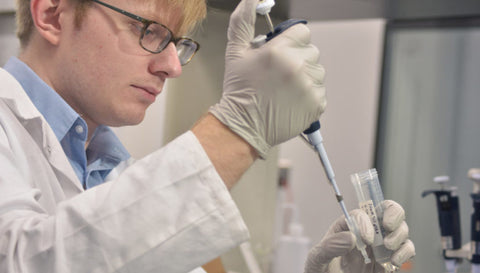High-Salt Loading Conditions

This blog post about high-salt loading conditions is the first in a series about optimizing conditions for affinity protein purification. Read parts two and three.
When conducting affinity purification of a protein, there are many variables to consider in order to optimize purity and yield. One such condition to control is high-salt loading, which decreases impurities in the final product.
Why use a high salt loading buffer?
Using a high-salt concentration loading buffer is crucial in ensuring the high purity of the resulting protein product. High salt decreases non-specific binding between the protein of interest and impurities by interrupting the electrostatic interactions between them. The loading stage is the best time to use a high salt concentration buffer because impurities become more difficult to remove later during the wash stages.
Depending on the protocol, washing steps may also use high-salt washes alternated with low salt washes. This back and forth removes impurities by “shocking” the system via a high salt differential to break up the stronger non-specific binding.
What proteins can withstand high salt loading?
The higher the binding affinity between the tag and the fusion partner, the more salt-tolerant the system. High-salt conditions are not generally used in other protein purification methods such as ion exchange. For example, ion exchange chromatography depends on non-specific charge interactions between the protein and the column. This method requires low salt conditions because high salt would disrupt the weak affinity. A high-salt gradient is used in the final step to elute the protein by disrupting the interactions. Affinity chromatography is superior in this regard because it depends on specific binding between the tag and the ligand, allowing non-specific interactions to be largely weeded out.
Soluble proteins
Soluble proteins can generally better withstand high salt conditions. A phenomenon called “salting out” can cause insoluble proteins to aggregate and precipitate out of solution due to the charge of the salt ions. Affixing a solubility tag to the protein of interest could help the solubility of the protein in high salt, but keep in mind that cleavage of the tag could cause the protein’s precipitation out of solution.
DNA/RNA-binding proteins
High salt is especially important when purifying proteins that are known to bind nucleic acids. These are normally soluble and do not have issues with salt tolerance, so they can withstand concentrations above 1 M NaCl. Using high-salt loading is the only way to purify nucleic acid-binding proteins in one step; otherwise, further chromatography steps are required to remove contaminants. Sometimes, DNAse is used to ensure that all DNA components are removed when purifying DNA or RNA binding proteins. However, high-salt loading is easier, cheaper, faster, and in general sufficient.
Membrane proteins
Membrane proteins can be challenging to purify, but once they are solubilized they are no different than other proteins and potentially can be treated with high salt. High salt can be used to separate integral membrane proteins from peripheral membrane proteins. It disrupts the polar interactions between the proteins that span the lipid bilayer and those that are only associated with it.
Proteins with hydrophobic regions
Proteins with hydrophobic elements do not have a rule of thumb for whether they are tolerant or sensitive to high salt. High salt will move the water surrounding a protein back into the bulk solvent, therefore exposing any hydrophobic patches. These regions then interact with each other and cause the protein to precipitate. If the patches are small enough or internal, the protein could still be soluble in high salt. In general, if the protein is very large there are more opportunities for hydrophobic exposure and is likely more sensitive in high salt.
How do I choose a salt concentration for my buffers?
Choosing a salt concentration for loading depends on the protein’s properties. If the affinity between tag and ligand is near covalent or the protein is known to be soluble, then it is likely that high-salt conditions can be used successfully.
Most proteins, if they are well-folded and contain no hydrophobic patches, can handle at least a 0.5 M salt concentration. Even if nothing is known about the protein’s structure, 0.5 M is still the recommended starting point. If 0.5 M is too high, there is likely something amiss with regards to the protein’s folding properties or an exposed hydrophobic region.
Testing for an optimal salt concentration
A too-high salt concentration may result in a visibly larger pellet after lysis due to increased precipitation of the expressed protein. However, pellet size can be difficult to distinguish, especially if the protein’s expression levels were low to begin with. To be certain that high amounts of protein precipitated, gel analysis of the lysate fractions would show if the amount of recombinant protein in the pellet was greater than the amount in the supernatant.
Another way to test salt tolerance would be to use PEI precipitation. In an aliquot of lysate with 0.5 M NaCl, most soluble proteins would stay dissolved in the supernatant, even those that are nucleic acid-binding. If the protein does precipitate, then this may indicate a further issue with purification and solubility related to its folding or surface properties. Highly acidic proteins may also precipitate in mid-range salt concentrations in the presence of PEI.
Note: PEI is a cationic polymer that binds negatively charged molecules such as DNA and acidic proteins. The salt concentration AND the charge on your protein will determine solubility and may not have to do with folding or hydrophobic surfaces.
Summary
Using a high-salt concentration loading buffer is one of the simplest ways to ensure a high purity protein after purification. With a little knowledge about your protein of interest’s properties or a little extra time for testing, conditions can easily be modified to fit your individual needs.
TriAltus’ CL7/Im7 system is highly tolerant to high-salt loading conditions. Read more in our protocol about options for high-salt loading.
